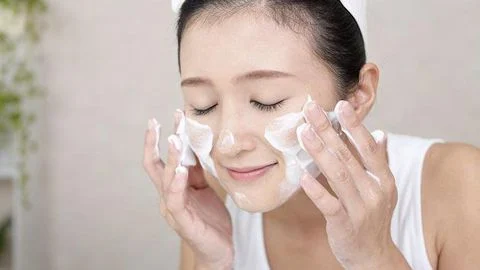According to experts, using skin care products in the correct order of using cosmetics will help the skin receive the full benefits of each product. Many of you wonder which one to use first, serum or moisturizer? Here are 11 steps to answer this question, and these steps are taken in the morning to help protect your skin before you leave the house.
Step 1: Use an oil-based cleanser
Facial cleansers come in two forms: water-based and oil-based. The oil-based variety is intended to dissolve the oils produced by your own skin.
How to use: Some oil-based cleansers are designed to work on wet skin or on dry skin. Read the instructions carefully before applying a small amount to your skin. Massage gently and rinse thoroughly with water before drying with a clean towel.
Skip this step if: (1) Your cleanser contains purely oil, rather than a mixture of oils, surfactants, and emulsifiers, and (2) you have combination or oily skin to avoid increased oil.

Step 2: Water-based cleanser
Water-based cleansers mainly contain surfactants that allow water to wash away dirt and sweat. In addition, this substance can also remove residual oils from the oil-based cleanser in step 1.
How to use: wet your face, apply cleanser to your face and massage gently, then rinse with water before drying with a clean towel.
Skip this step if: You don’t want to use two cleansers or if your oil-based cleanser contains enough surfactants to remove dirt and debris.
Step 3: Toner and astringent (astringent)
Toners are designed to replenish water through hydration and remove dead cells and dirt left behind after washing your face. An astringent is an alcohol-containing product used to combat excess oil.
How to use: Use immediately after washing your face, apply directly to the skin or apply with a cotton pad and swipe from the inside out.
Skip the astringents if: You have dry skin.
Step 4: Antioxidant serum
Serums contain high concentrations of certain ingredients. An antioxidant protects the skin against damage caused by unstable molecules called free radicals. Vitamins C and E are popular antioxidants used to improve skin texture and firmness.
How to use: apply a few drops to face and neck and pat gently.
Step 5: Spot treatment
If you have blemishes from acne, first find an anti-inflammatory product to get rid of acne, then move on to a dry spot treatment to fade the blemishes.
How to use: Use a damp cotton swab to remove any skin care products on pimples. Apply a small amount of treatment and let dry naturally.
Skip this step if: You don’t have acne or want to let the dark spots caused by acne fade naturally.
Step 6: Eye cream
The skin around your eyes tends to be thinner and more sensitive. It is also susceptible to aging causing wrinkles, eye bags and dark circles. A good eye cream can brighten, smooth and firm the area, although it cannot solve these problems completely.
How to use: Put a small amount of cream on your ring finger and apply to the area around your eyes.
Skip this step if: Your moisturizer and serum are already suitable for the eye area, contain an effective formula, and are fragrance-free.

Step 7: Lighter face oil
The lighter the product, the easier it is to use. The oil is easily absorbed and therefore should be used before moisturizer. These products are especially helpful if your skin shows signs of dryness, flakiness, or dehydration.
How to use: Squeeze a few drops onto your fingertips. Rub this product gently together to warm the oil before you gently apply it to your face.
Step 8: Moisturizer
Moisturizer will soothe and soften the skin. Dry skin types should choose cream or balm. This product in cream form works well on normal or combination skin, and liquids and gels are recommended for oily skin types. Ingredients in moisturizers include glycerine, ceramides, antioxidants and peptides.
How to use: Take an amount slightly larger than a pea size and gently rub in the palm of your hand. Apply to cheeks first, then the rest of the face.
Skip this step if: Your toner or serum gives you enough moisture, especially for those with oily skin.

Step 9: oil with large molecular size (Heavier face oil)
This type of oil is most suitable for dry skin types, but should be applied after moisturizer to help increase skin hydration.
How to use: Follow the same procedure as light oil.
Skip this step if: You don’t want to increase the risk of clogging your pores.
Step 10: Sunscreen
Sunscreen is the last important step in your morning skin care routine. Not only does it reduce the risk of skin cancer, but it can also fight signs of aging. The American Cancer Society recommends choosing a sunscreen with an SPF number of 30 or higher.
How to use: Apply evenly on face and massage. Apply 15 to 30 minutes before you go outside. Never apply skin care products on top of sunscreen, as this can dilute the sunscreen.
Step 11: Foundation or other base makeup
If you want to wear makeup, a foundation will give you smooth, even skin. Choose a cream, liquid or powder foundation – or a light-toned moisturizer or BB cream.
How to use: Use a brush or sponge to apply makeup. Start in the center of the face and apply outward.
Skip this step if: You have a bare face.
Source: healthline


